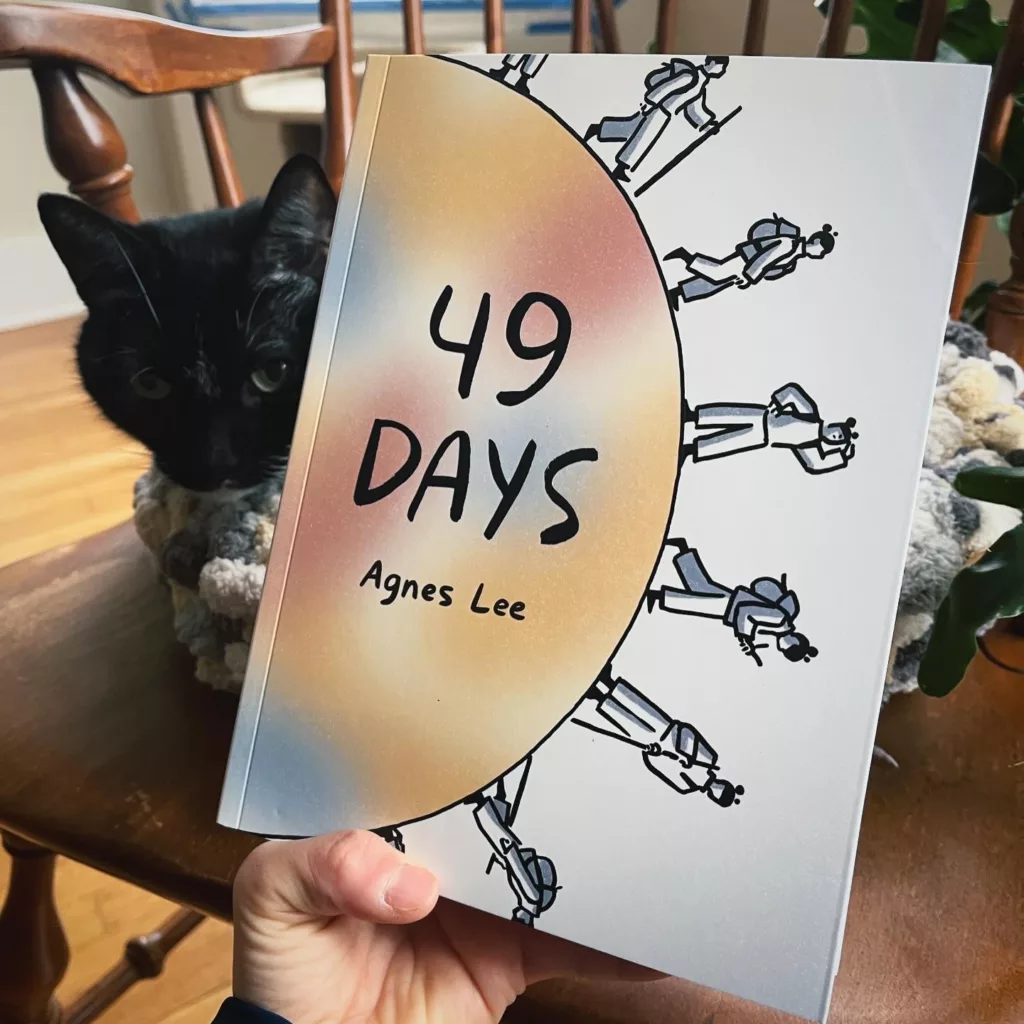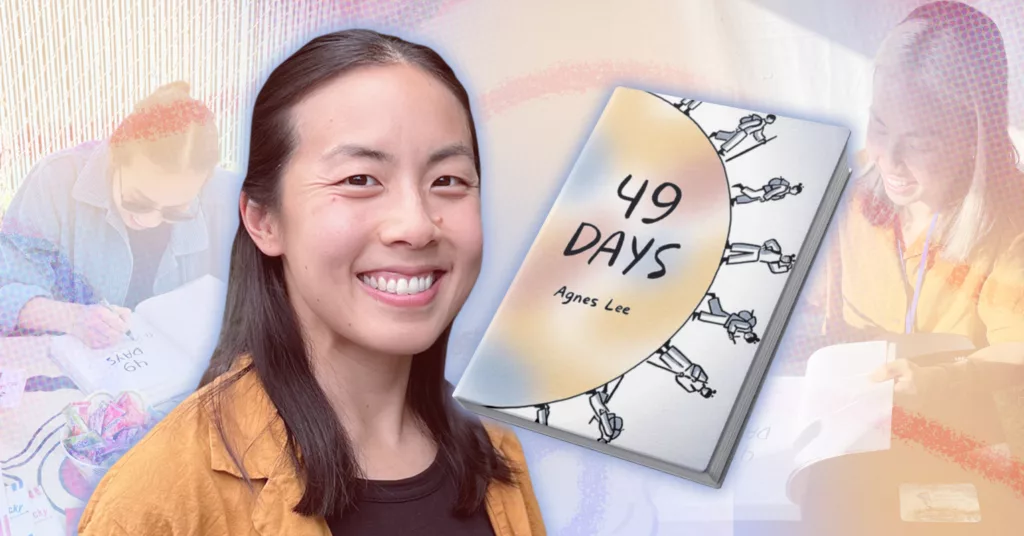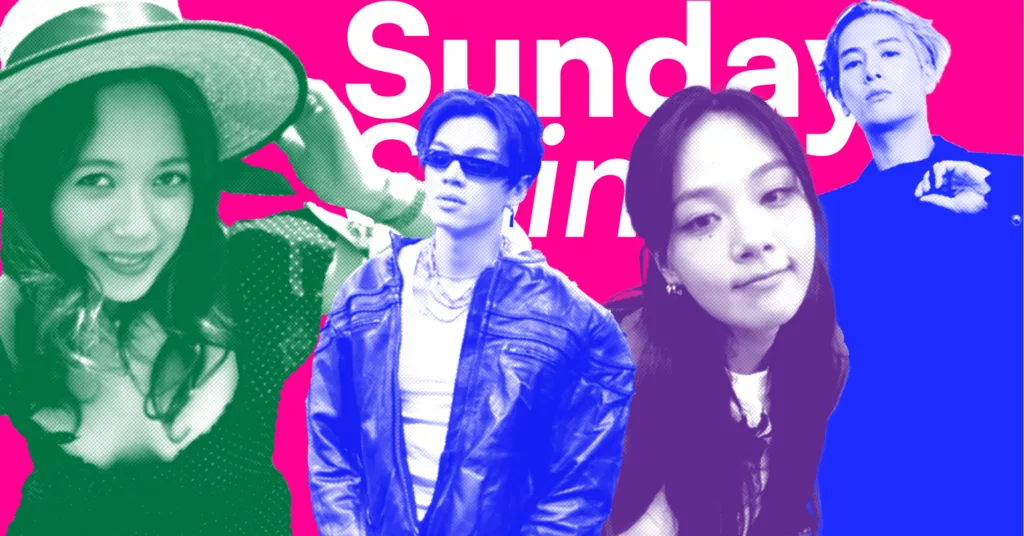“Day 1. Gotta get up. Gotta keep moving.” The journey starts on a blazing day by the shore. Comic artist Agnes Lee’s debut graphic novel 49 Days takes a spin on the Buddhist belief that the soul of a person who has passed must travel for 49 days before being fully crossing into the next life. As a book about loss and remembrance, 49 Days captures a unique perspective on life in the “in-between” space before a soul’s final resting place. This story follows protagonist Kit as she travels alone, while remnants of her life and love sent from her family follow her throughout her journey. Lee, joined by her beloved cat Muta, sat with EnVi for a video call to discuss the making of her first graphic novel.
From the New York Times to Published Author
Lee grew up in California, where she spent most of her life, before moving to New York City around seven years ago. Freelancing for editorial and illustration jobs landed her a contract role as an art director for the New York Times in 2017. Lee had her “claim to fame” when she started illustrating for the weekly Metropolitan Diary. In working on these comics, the executive editor of independent publisher Levine Querido Nick Thomas, found her in an unconventional way. “At the Times, I had done an illustration for an article, I think it was about impostor syndrome. If I remember correctly, it was a flamingo on a duck, but it led [Thomas] to my website,” Lee said, smiling as she thought back on the moment. “He reached out asking if I was ever interested in doing a full-length graphic novel, and I was like, ‘totally, that’s like my dream come true.’”
Thomas took Lee in as a first-time graphic novelist, fostering her creativity and giving her the freedom to explore what she wanted to do. “He was very open [and] willing to work with me on creating an idea that would be good for publishing,” Lee said. After going back and forth with ideas, Lee presented an old project she had worked on briefly for a Comic Risograph class at the School of Visual Arts. The class was canceled because of the COVID-19 pandemic, but the idea for the comic remained. Though the initial vision for the project was to be a short form comic, Lee felt it could have the potential for a longer story. “I was very lucky because Nick saw the ‘chicken scratch’ sketches and he was like, ‘I love this idea, let’s get the ball rolling,’” Lee recalled.
Thus, the story of 49 Days came to a full production for around three years before being released to the world on March 5, 2024.

Honoring Loved Ones
“[49 Days is] based on my experience with losing my best friend from high school. He passed away a pretty long time ago, [about] 15 years ago. It was really unexpected,” Lee revealed. “It was the first major death in my life — for someone to be so close to me and certainly not have them be there [anymore]. So there’s a really long period of time where I was trying to process it and even now, I’m still processing it,” she continued.
Lee described how being a creative naturally led her to try different ways to output life experiences into her work. She created multiple short comics before getting the idea to process and write about her loss and grief. “I think touching on that [grief and processing loss] is a really personal journey, but there are no rules to it, so I hope my book shows that it’s really however you want it to be,” Lee told EnVi. She also highlighted the importance of talking to your loved ones and showing gratitude towards them.
In the book, Kit’s family showed their grief in different ways. Her mother outwardly prayed over a picture of Kit and seemed to grieve quietly, while her little brother made his own shrine for Kit where he put together trinkets from her belongings in secret. Kit’s older sister Sam’s emotions got the best of her as she expressed a sour attitude towards praying.
“I think this is a way to show others that religion or beliefs, or however you want to process whatever just happened, it’s really personal to you. If this makes you feel better and if this helps you move forward, then I think that’s enough. It doesn’t need to adhere to religious rules, whatever they may be,” Lee expressed.
Drawing Inspiration From Personal Experiences
“A lot of the inspiration is taken from my dreams. I would see [my best friend] in my dreams a lot,” Lee said. “And I always kind of imagined what this other world was kind of like.” It was important to Lee not to base Kit completely off of her friend, as she wanted to protect his life and memory. Lee lightly joked about not being a creative person, which led her to draw from her life and personal experiences. From moments of being Korean American to being surrounded by nature, many aspects of Lee’s life seeped into Kit’s character and story.
A notable memory for Lee is featured throughout the novel —making kimchi with her mom — which is shown through Kit.
The first of Kit’s memories shown are the scenes of her and her mom making kimchi. The scenes of her childhood self show an adversity to making kimchi, due to the food’s odor and related bullying. It came full circle as she grew up and started to embrace her culture’s food, even learning how to make some dishes. Another moment that completes the cycle is when Kit’s mother, brother, and sister make kimchi and bond together after quietly grieving Kit’s death. At first, Lee was hesitant to include the kimchi scene, as it played into the “classic Asian American experience” of receiving judgment from others for eating one’s own cultural food — she was worried about it being “cliche.” After some consideration, Lee realized this was a valid experience she underwent and wanted to share.
“When I moved away, I realized that kimchi was a really big part of my culture […] A way to show love and connectedness with my family,” Lee expressed. “[Asian parents] don’t say anything, but they love to say things with food.” Lee portrayed this type of connection and love with scenes of preparing and sharing meals, rooted in Kit’s memories and her family’s reality after Kit’s death.
As someone who grew up in California, Lee was constantly exposed to nature. She has hiked in all types of settings, from foggy places to rocky situations. Much of Lee’s outdoor ventures are reflected in the “in-between” through which Kit journeys. The book opens with Kit’s first day after death where she finds herself along a raging shore where she is battling the tides. Lee shared how these scenes are based on her experiences backpacking to the Lost Coast. “You do have to pay attention to the tides, or else you will be stuck,” Lee mentioned.
“I feel like when you’re in nature, it can feel really creepy sometimes or you can feel very removed […] It’s such a powerful force that you can’t control and pretty much anything can happen,” Lee conveyed as she continued to talk about her experiences in nature. “There’s so many different settings, so I thought it was really appropriate for her to be in this [place] that was familiar, but very unfamiliar at the same time.”
Navigating the Creation Process
When Lee was given the greenlight to create her book, she admitted that she didn’t know what to do. Even as she turned to others for inspiration, she had to figure out what worked for her on her own terms. “I’ve never worked on a book or a project for this long or at this scale, so it felt really scary to do that,” Lee acknowledged. “I had very clear ideas of how the beginning and end of this book were going to [happen], but all the in-between stuff I got very nervous about. [Things like] keeping the characters consistent and sometimes thinking about architecture.”
Lee mentioned having a lot of self-doubt during the creative process. “There were a lot of [thoughts like] ‘Is this good enough? Am I doing the story justice? Are people even gonna like it?’” Lee was able to push through these unpleasant feelings by creating a routine for herself — setting small goals and tasks to complete everyday helped her stay consistent.
Another aspect of the illustration process was completing the bulk of drawing by hand. Digital programs have facilitated art production in recent years, but for Lee, freehand drawing is a faster and more natural method. “I’ve done a few things digitally, but I struggle with digital work. I feel too caught up in the digital aspect. I’m like, ‘I can just control Z it,’ or wonder, ‘What kind of brush should I use?’ There’s too many options,” Lee said. “When I can eliminate things and know my tools are a brush or pen and this piece of paper, I feel very much more connected to my artwork.”
What Lies Beyond 49 Days?
After wrapping up the book, Lee felt a lot of closure at seeing everything come altogether. However, she continued to have some self doubts and even put off looking through her book in its entirety right before it came out. “This isn’t that bad!” Lee mimicked herself when she realized part of the process of creating something is “accepting that you did something.”
Readers’ connection with 49 Days has truly filled Lee with much appreciation. “There’s been more tears than I expected. I think so many people came up to me and were like, ‘Oh, I cried a lot [reading] this book.’ I feel very humbled that my story was able to move someone to the point of tears,” Lee highlighted as she expressed her gratitude. “I just appreciate that people are taking the time to read it. It feels very surreal, but I’m really touched by all the comments.”
Lee and her editor have been discussing potential ideas for a second graphic novel. Lee lightheartedly confessed to not having any specific ideas yet, but she is interested in further exploring her Korean American identity. “I’ve been really getting into Korean folklore and fairytales, so maybe there’s something there,” Lee told EnVi. “Whatever my second book may be, I just hope it’s a genuine story I can tell.”
49 Days is available for purchase on Amazon, Barnes & Noble, Bookshop, and Books-A-Million. Keep up with Lee and her cat Muta on her Instagram.
Interested in more artists who are creating comics? Check out our interview with NYC-based cartoonist Yao Xiao here!




